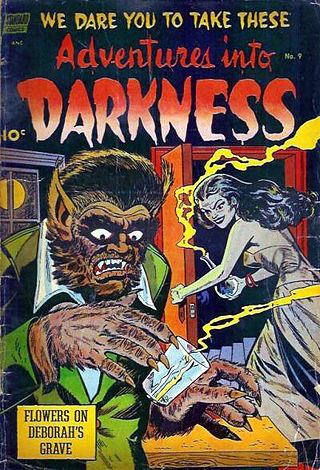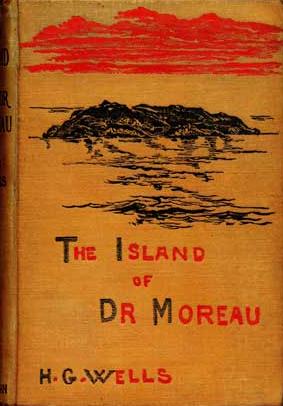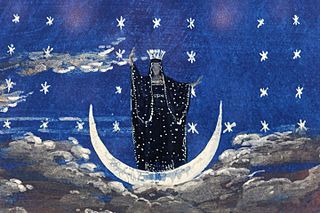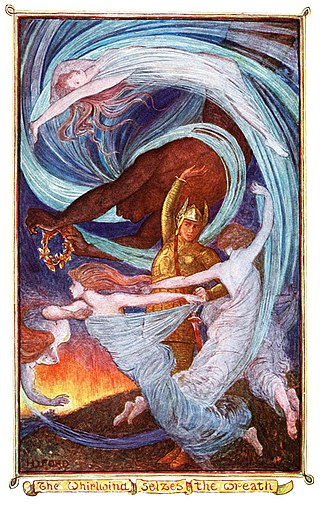
Pellucidar is the internal surface of a fictional Hollow Earth invented by American writer Edgar Rice Burroughs for a series of action adventure stories. In a crossover event, Tarzan, who was also created by Burroughs, visits Pellucidar.

The hippogriff or hippogryph is a legendary creature with the front half of an eagle and the hind half of a horse.

John Carter of Mars is a fictional Virginian soldier who acts as the initial protagonist of the Barsoom stories by Edgar Rice Burroughs. A veteran of the American Civil War, he is transported to the planet Mars, called Barsoom by its inhabitants, where he becomes a warrior battling various mythological beasts, alien armies and malevolent foes. Created in 1911, the character has appeared in novels and short stories, comic books, television shows and films, including the 2012 feature film John Carter, which marked the 100th anniversary of the character's first appearance.

Dion Fortune was a British occultist, ceremonial magician, novelist and author. She was a co-founder of the Fraternity of the Inner Light, an occult organisation that promoted philosophies which she claimed had been taught to her by spiritual entities known as the Ascended Masters. A prolific writer, she produced a large number of articles and books on her occult ideas and also authored seven novels, several of which expound occult themes.

Fantastic Beasts and Where to Find Them is a 2001 guide book written by British author J. K. Rowling about the magical creatures in the Harry Potter universe. The original version, illustrated by the author herself, purports to be Harry Potter's copy of the textbook of the same name mentioned in Harry Potter and the Philosopher's Stone, the first novel of the Harry Potter series. It includes several notes inside it supposedly handwritten by Harry, Ron Weasley, and Hermione Granger, detailing their own experiences with some of the beasts described, and including inside jokes relating to the original series.

Werewolf fiction denotes the portrayal of werewolves and other shapeshifting therianthropes, in the media of literature, drama, film, games and music. Werewolf literature includes folklore, legend, saga, fairy tales, Gothic and horror fiction, fantasy fiction and poetry. Such stories may be supernatural, symbolic or allegorical. A classic cinematic example of the theme is The Wolf Man (1941) which in later films joins with the Frankenstein Monster and Count Dracula as one of the three famous icons of modern day horror. However, werewolf fiction is an exceptionally diverse genre, with ancient folkloric roots and manifold modern re-interpretations.

The Island of Doctor Moreau is an 1896 science fiction novel by English author H. G. Wells. It was published on 1 January 1896. The novel is set between 21 January 1887 to 5 January 1888. The text of the novel is the narration of Edward Prendick, a shipwrecked man rescued by a passing boat. He is left on the island home of Doctor Moreau, a mad scientist who creates human-like hybrid beings from animals via vivisection. The novel deals with a number of themes, including pain and cruelty, moral responsibility, human identity, human interference with nature, and the effects of trauma. Wells described it as "an exercise in youthful blasphemy."
A variety of magical creatures are depicted in the fictional universe of Harry Potter, which is drawn from various types of media. Magical creatures appear in the Harry Potter novels and their film adaptations, in the Fantastic Beasts film series, in other books by J. K. Rowling, and on the website of the Wizarding World media franchise. In 2001, Rowling released Fantastic Beasts and Where to Find Them, which serves as a guidebook to the creatures described in the fictional universe. Some of these creatures were invented by Rowling. Others are derived from sources such as Greek mythology, English and Celtic folklore, and the works of Roman historians.

There is a belief common to many cultures that working rituals at the time of different phases of the moon can bring about physical or psychological change or transformation. These rituals have historically occurred on or around the full moon and to a lesser extent the new moon. Such practices are common amongst adherents of neopagan and witchcraft systems such as Wicca.

The First Men in the Moon by the English author H. G. Wells is a scientific romance, originally serialised in The Strand Magazine and The Cosmopolitan from November 1900 to June 1901 and published in hardcover in 1901. Wells called it one of his "fantastic stories". The novel recounts a journey to the Moon by the two protagonists: a businessman narrator, Mr. Bedford; and an eccentric scientist, Mr. Cavor. Bedford and Cavor discover that the Moon is inhabited by a sophisticated extraterrestrial civilisation of insect-like creatures they call "Selenites". The inspiration seems to come from the famous 1865 book by Jules Verne, From the Earth to the Moon, and the opera by Jacques Offenbach from 1875. Verne's novel also uses the word "Selenites" to describe inhabitants of the Moon.

In science fiction and fantasy literatures, the term insectoid ("insect-like") denotes any fantastical fictional creature sharing physical or other traits with ordinary insects. Most frequently, insect-like or spider-like extraterrestrial life forms is meant; in such cases convergent evolution may presumably be responsible for the existence of such creatures. Occasionally, an earth-bound setting — such as in the film The Fly (1958), in which a scientist is accidentally transformed into a grotesque human–fly hybrid, or Kafka's famous novella The Metamorphosis (1915), which does not bother to explain how a man becomes an enormous insect — is the venue.
Pan, the Greek deity, is often portrayed in cinema, literature, music, and stage productions, as a symbolic or cultural reference.

Fantasy is a genre of speculative fiction which involves themes of the supernatural, magic, and imaginary worlds and creatures.

Monster literature is a genre of literature that combines good and evil and intends to evoke a sensation of horror and terror in its readers by presenting the evil side in the form of a monster.
A monstrous birth, variously defined in history, is a birth in which a defect renders the animal or human child malformed to such a degree as to be considered "monstrous". Such births were often taken as omens, signs of God, or moral warnings to be wielded by society at large as a tool for manipulation in various ways. The development of the field of obstetrics helped do away with spurious associations with evil but the historical significance of these fetuses remains noteworthy. In early and medieval Christianity, monstrous births were presented as and used to pose difficult theological problems about humanity and salvation.

A human–animal hybrid and animal–human hybrid is an organism that incorporates elements from both humans and non-human animals. Technically, in a human–animal hybrid, each cell has both human and non-human genetic material. It is in contrast to an individual where some cells are human and some are derived from a different organism, called a human-animal chimera.

Newton Artemis Fido "Newt" Scamander is a fictional character and the protagonist of the Fantastic Beasts film series.











